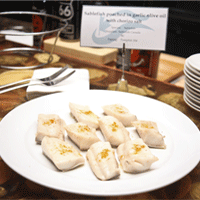TORONTO – On Wednesday, Sept. 30, seafood growers from across Canada gathered at Starfish Oyster Bed & Grill in downtown Toronto to meet with food writers, talk about the industry and showcase the high quality and diversity of Canada’s aquaculture products.
Ruth Salmon, executive director of the Ottawa-based Canadian Aquaculture Industry Alliance, organized the event, which was hosted by Starfish owner and champion oyster-shucker Patrick McMurray.
More than a dozen species of fish and seafood from the Pacific and Atlantic coasts, Ontario and the Yukon were prepared by award-winning seafood chef Kyle Deming. Dishes included Rainbow trout from Ontario, salmon, scallops and sablefish from B.C. (the latter poached in garlic olive oil with chorizo salt), Arctic char from the Yukon, mussels from P.E.I. and halibut from Nova Scotia (whole roasted with chive butter). Atlantic cod was also on the menu, a species being farmed in Canada for the first time. Brewmaster John Bowden of Great Lakes Brewing was on hand, pairing his company’s craft beers — like the new seasonal offering, pumpkin ale — with each offering.
With a significant rise in the popularity of seasonal, regional cuisine and a nationwide push to support local producers and sustainable food systems, there has been a backlash against farmed fish driven by chefs and restaurateurs in the foodservice industry. The members of the Canadian Aquaculture Industry Alliance hoped the event would help demystify some of the negativity around farmed fish.
“It’s nice to see someone finally showcasing aquaculture product,” said oyster-shucker McMurray.” We have to balance wild fish consumption with aquaculture, which is good for everyone. More people need to eat seafood. Oysters have been cultured in China since 300 B.C. Product today is consistent. You know exactly what it is and where it came from.”
“Global demand for seafood is growing,” said organizer, Salmon, “and to meet that demand, we need to farm more fish. But we also need to farm it in a sustainable way.” Salmon noted that 20, and even 10 years ago, there were many mistakes made by the farming industry before new methods, that have a much lower impact on the ecosystem, were developed.
“The sustainable farming business is totally self-contained, and it does not hurt wild salmon stocks,” says Sam Bowman, sales manager for Marine Harvest Canada, which is a grower based out of Campbell River, B.C. “Farms today are in remote areas, where the water quality is not a problem. In the old days, farms used to be in protected coves, but today they’re meant to mimic the natural environment.”
According to Bowman, who is also a marine biologist, a typical salmon farm is made from a 100-foot-long cage that is anchored to the seafloor in deep water where there’s a strong current. Just two per cent of the volume of water is made up of fish. Fish are fed every day and the current dissipates the feces, with some of it settling at the bottom of the cages. “In regular intervals we allow the farms to lay fallow and the current eventually brings the bottom sediment to the surface. It’s all monitored, and nitrate level must be below a certain threshold before the farm is started up again.”
Eggs are hatched in fresh water where they transform into smolts, which takes about a year, says Bowman. From there, they’re moved into salt-water farms where they spend the next 15 to 20 months. A typical cycle is about three years.
When asked about criticism of farmed fish by many in the food industry, who believe the farming is causing serious damage to the sea, and to its many inhabitants, Bowman noted that today’s farming methods are far removed from those of the past and that the farming industry is eager to work with non-profit groups like Ocean Wise to help benefit the seafood industry as a whole. “I am a marine biologist, and I consider myself an environmentalist,” he said. “That is why I got into aquaculture in the first place. Fish welfare is important to us. It’s our livestock.”
Quick facts:
According to Ruth Salmon, executive director of the Canadian Aquaculture Industry Alliance:
• Fish is farmed in every province in Canada, with 12 available species available at all times.
• Fish farming is a $1-billion industry that directly employs 16,000 people
• 160,000 tons of seafood is grown in Canada, which only makes up two per cent of global production
• Half of the world’s seafood is now farmed


















